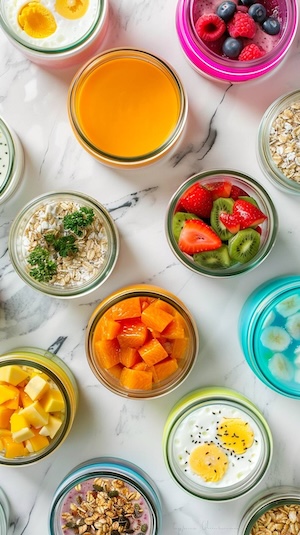PCOS for Picky Eaters: 30 Simple Meal Ideas
Discover 30 simple pcos meals for picky eaters that help manage symptoms. Easy pcos meals picky eaters will love, with practical tips and hormone-balancing ingredients.
Recipe by Einat Admony What's wonderful about challah is that it can be used in so many ways: to sanctify the Sabbath, of course, but just as important, to make French toast, grilled cheese, and croutons and as breading in meatballs. Maybe not the way Go
This recipe includes superfoods such as:
Transform your health with tailored 7-day meal plans designed specifically for PCOS management. Just $7/month or $59/year.
Get it now →2 1/2 cups whole milk or water
8 2/3 cups all-purpose flour, plus flour for the work surface
1 1/2 tablespoons active dry yeast
1/2 cup honey or sugar
1/4 cup canola oil, plus more oil for the bowl
4 large eggs
1 1/2 tablespoons kosher salt
White sesame or nigella seeds for sprinkling
Heat the milk in a small saucepan over low heat just until it's warm to the touch. Remove from the heat.
Dump the flour into a large bowl and make a well in the center. Add the yeast to the well along with a few drops of honey and 1/2 cup or so of the warm milk. Let stand until foamy, about 10 minutes.
In a separate bowl, combine the remaining milk and honey, the oil, and 3 of the eggs. Stir together. Add the salt and stir again. Gradually stir the liquid mixture into the flour, about 1/2 cup at a time. When the dough becomes sticky and difficult to stir, dump onto a floured surface and knead it by hand, adding a little more flour if necessary to keep it from sticking, until smooth and elastic.
Knead the dough into a ball. Slick another large bowl with oil, add the dough, and turn to slick the surface with oil. Cover with a damp cloth and let stand in a warm place until double in size, 1 to 1 1/2 hours.
Line 2 baking sheets with parchment paper. Gently punch the dough down and turn it onto a floured surface. Divide the dough into four equal portions, working with one portion at a time and keeping the rest covered with a damp cloth. Divide one portion of dough into three equal pieces and roll each piece into a rope about 1 foot long and slightly tapered at the ends. Line the ropes side by side on one side of the baking sheet and braid them, pinching the ends to seal and tucking them underneath. Repeat this process with the remaining dough until you have four nicely braided loaves. Cover with a damp cloth and let stand until nearly double in size, another 25 minutes or so.
Preheat the oven to 350 °F.
Lightly beat the remaining egg and brush it over the tops of the challah loaves. Sprinkle with the nigella or sesame seeds. Bake the loaves until golden brown, 20 to 30 minutes.

You know the drill: Alarm goes off. You hit snooze. Rush around frantically. Skip breakfast AGAIN because there's no time. By 10am, you're hangry, your blood sugar is all over the place, and your PCOS symptoms are already acting up.
Sound familiar?
Finally – a meal prep system designed specifically for women with PCOS who refuse to let chaotic mornings derail their health goals.
In just ONE hour on Sunday, you can transform your entire week:
"I went from skipping breakfast 4 days a week to having delicious, hormone-supporting meals ready every morning. My energy is more stable and my cravings have disappeared!"
– Sarah M.
Stop letting chaotic mornings control your health.
Get your hormone-happy mornings starting this Sunday.
→ Get Your 60-Minute Solution Now
Transform your health with tailored 7-day meal plans designed specifically for PCOS management. Just $7/month or $59/year.
Get it now →Serving Size: 4
| Amount Per ONE Serving | ||
|---|---|---|
| Calories 0 kcal | ||
| Fat 0 g | ||
| Carbohydrate 0 g | ||
| Protein 0 g | ||
💡 Introducing the 10/10 PCOS Solution:
Ten Delicious Crockpot Recipes that take just 10 minutes to prep!
Say goodbye to hours in the kitchen and hello to clean, PCOS-friendly meals made effortlessly.
👉 Click here to grab your 10/10 PCOS Solution today! Try The 10/10 PCOS Solution: Ten Crockpot Recipes That Take Just Ten Minutes to Prep
Managing PCOS can be challenging, but you don't have to do it alone. Join our supportive community to connect with others who understand what you're going through, share tips, and get encouragement. Here's how you can get involved:
Subscribe to our Newsletter: Receive PCOS-friendly recipes, tips, research updates, and more delivered straight to your inbox. Stay informed and empowered with the latest information and support.
Join our Telegram Channel: Stay updated with the latest tips and advice on managing PCOS.
Follow PCOS Meal Planner on Facebook: Engage with our community, participate in discussions, and get support from others.
Break the cycle with the PCOS Meal Planner - your personalized guide to eating better, feeling better, and managing PCOS symptoms. Take control today!

Forget the frustrating cycle of weight loss attempts, endless medications, and living in discomfort. Introducing the PCOS Meal Planner. A meal planning guide that goes beyond temporary fixes to offer a comprehensive strategy, empowering you to ignite a transformation towards lasting health and happiness. Step into a world where you control your PCOS, not the other way around.
Unlock Your PCOS Freedom Now.
Discover 30 simple pcos meals for picky eaters that help manage symptoms. Easy pcos meals picky eaters will love, with practical tips and hormone-balancing ingredients.
Discover 15 delicious overnight oats for PCOS recipes that help balance hormones and manage symptoms. Easy, nutritious breakfast ideas perfect for women with PCOS.
Discover the best cereal for PCOS with our expert rankings. Compare brands, check ingredients, and find PCOS friendly cereal that supports hormonal balance.
Learn how to transition away from fruit when starting a ketogenic diet for PCOS. Discover gradual strategies, fruit alternatives, and practical tips for success.
Discover 5 delicious PCOS banana bread recipes with low-glycemic ingredients. Learn how to make hormone-friendly banana bread that supports blood sugar balance.
Creatine for women with PCOS explained simply. Learn safety, benefits, hormone effects, tips, and how creatine may support PCOS symptoms naturally.
Complete PCOS diet plan with foods to eat, foods to avoid, meal timing, and real results. Learn the science-backed approach to managing PCOS through diet, with 7-day meal plan, grocery list, and step-by-step implementation guide. Based on clinical research and real patient outcomes.
Complete guide to ordering at Wendy's with PCOS. Discover the best protein-focused meals, what to skip, and how to customize orders to keep blood sugar stable. Learn which burgers, salads, and sides work for PCOS, plus complete macros for every menu item and smart swaps to avoid insulin spikes.
Complete guide to ordering at Burger King with PCOS. Discover the best protein-focused meals, what to skip, and how to customize orders to keep blood sugar stable. Learn which burgers, salads, and sides work for PCOS, plus complete macros for every menu item and smart swaps to avoid insulin spikes.